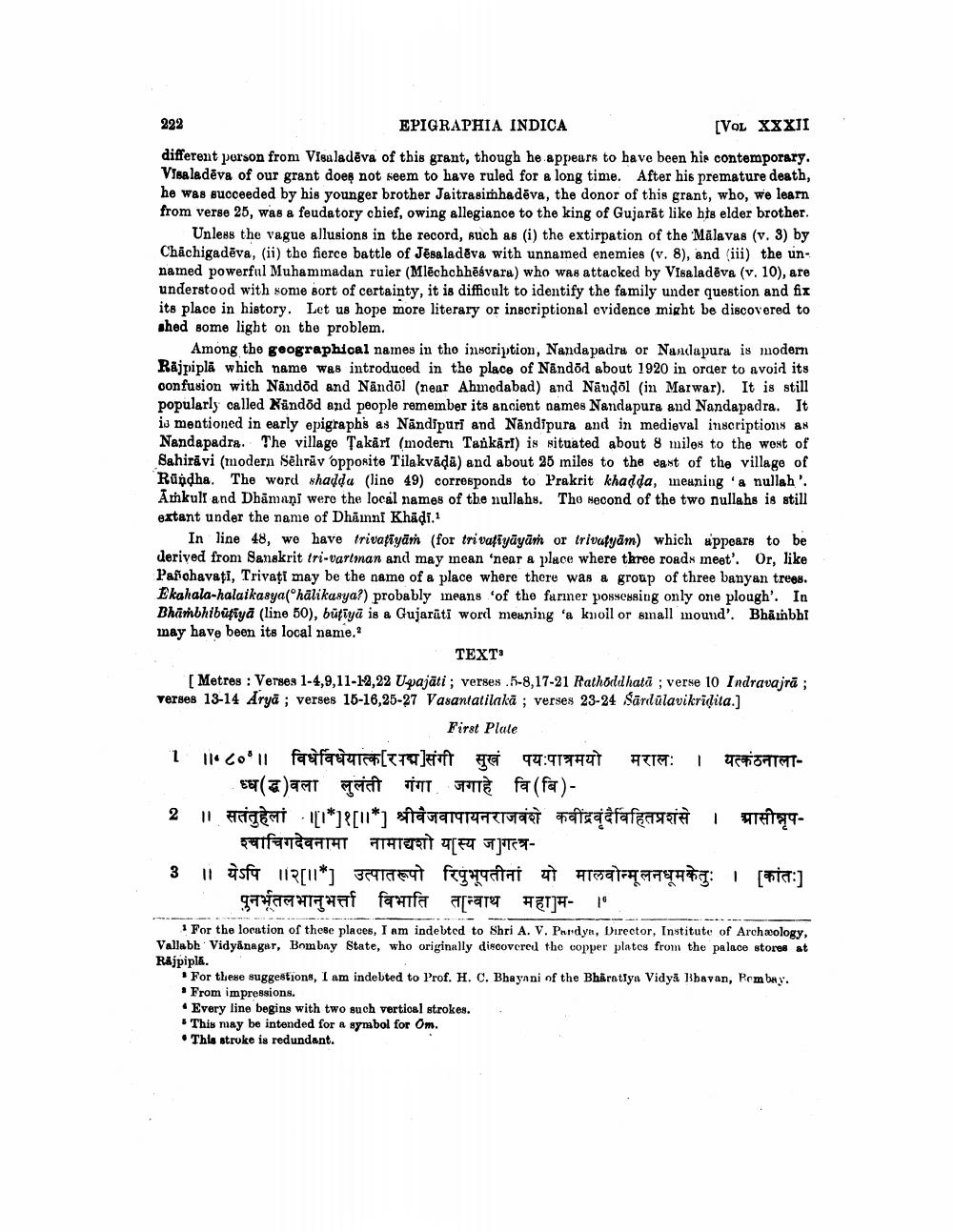________________
222
EPIGRAPHIA INDICA
[VOL XXXII
different person from Visu ladēva of this grant, though he appears to have been his contemporary. Visala dēva of our grant does not seem to have ruled for a long time. After his premature death, he was succeeded by his younger brother Jaitrasimhadēva, the donor of this grant, who, we learn from verge 25, was a feudatory chief, owing allegiance to the king of Gujarāt like his elder brother.
Unless the vague allusions in the record, such as (i) the extirpation of the Mālavas (v. 3) by Chāchigadēva, (ii) the fierce battle of Jēka ladēva with unnamed enemies (v. 8), and (iii) the unnamed powerful Muhammadan ruier (Mlēchchhēsvara) who was attacked by Visaladēva (v. 10), are understood with some sort of certainty, it is difficult to identify the family under question and fix its place in history. Let us hope more literary or inscriptional evidence might be discovered to shed some light on the problem.
Among the geographical names in tho inscription, Nanda padru or Nandapura is modern Rajpipla which name was introduced in the place of Nandöd about 1920 in order to avoid its confusion with Nandod and Nandol (near Ahmodabad) and Nāudol (in Marwar). It is still popularly called Nündöd and people remember its ancient names Nandapura and Nandapadra. It is mentioned in early epigraphs as Nandipuri and Nandipura and in medieval inscriptions as Nandapadra. The village Takärl (modern Tankari) is situated about 8 miles to the west of Sahirāvi (modern Sēlräv opposite Tilakvāda) and about 25 miles to the east of the village of Rundha. The word shadda (line 49) corresponds to Prakrit khadda, meaning 'a nullah'. Āmkull and Dhamani were the local names of the nullahy. The second of the two nullahs is still extent under the name of Dhainni Khadi.
In line 48, we have trivatīyāṁ (for trivasiyāyām or trivatyäm) which appears to be derived from Sanskrit tri-vartman and may mean 'near a place where three roads meet'. Or, like Panohavați, Trivaţi may be the name of a place where there was a group of three banyan trees. Ekahala-halaikasya(halikasya?) probably means of the fariner posscusing only one plough'. In Bhabhibūfīyā (line 50), büfiya is a Gujarati word meaning 'a koil or small mound'. Bhainbhi may have been its local name.?
TEXTз Metres : Verses 1-4,9,11-12,22 Uvajāti; verses 5-8,17-21 Rathordhatā ; verse 10 Indravajrā; verses 13-14 Arya ; verses 15-16,25-27 Vasantatilakā; verses 23-24 Sārdūlavikridila.]
First Plate 1 ॥८०॥ विधेविधेयात्कारसम]संगी सुखं पयःपात्रमयो मराल: । यत्कंठनाला
()21 siti TITT TITÈ fa (fa)2 | HITENI [1*]0[11*) star tet prateadfafegit | Haq
श्वाचिगदेवनामा नामाद्यशो यास्य जगत्त्र3 11 asfq 11111* SITTETT FTTHAT TAOT H AI: 1 pais:)
पून तलभानुभर्ता विभाति तान्वाथ महाम- ।' For the location of these places, I am indebted to Shri A. V. Pordyn, Director, Institute of Archæology, Vallabh Vidyanagar, Bombay State, who originally discovered the copper plates from the palace stores at Rajpipla.
. For these suggestions, I am indebted to Prof. H. C. Bhayani of the Bharatiya Vidya Bhavan, Pembay. . From impressions. • Every line begins with two such vertical strokes. . * This may be intended for a symbol for Om. • Thla stroke is redundant.




